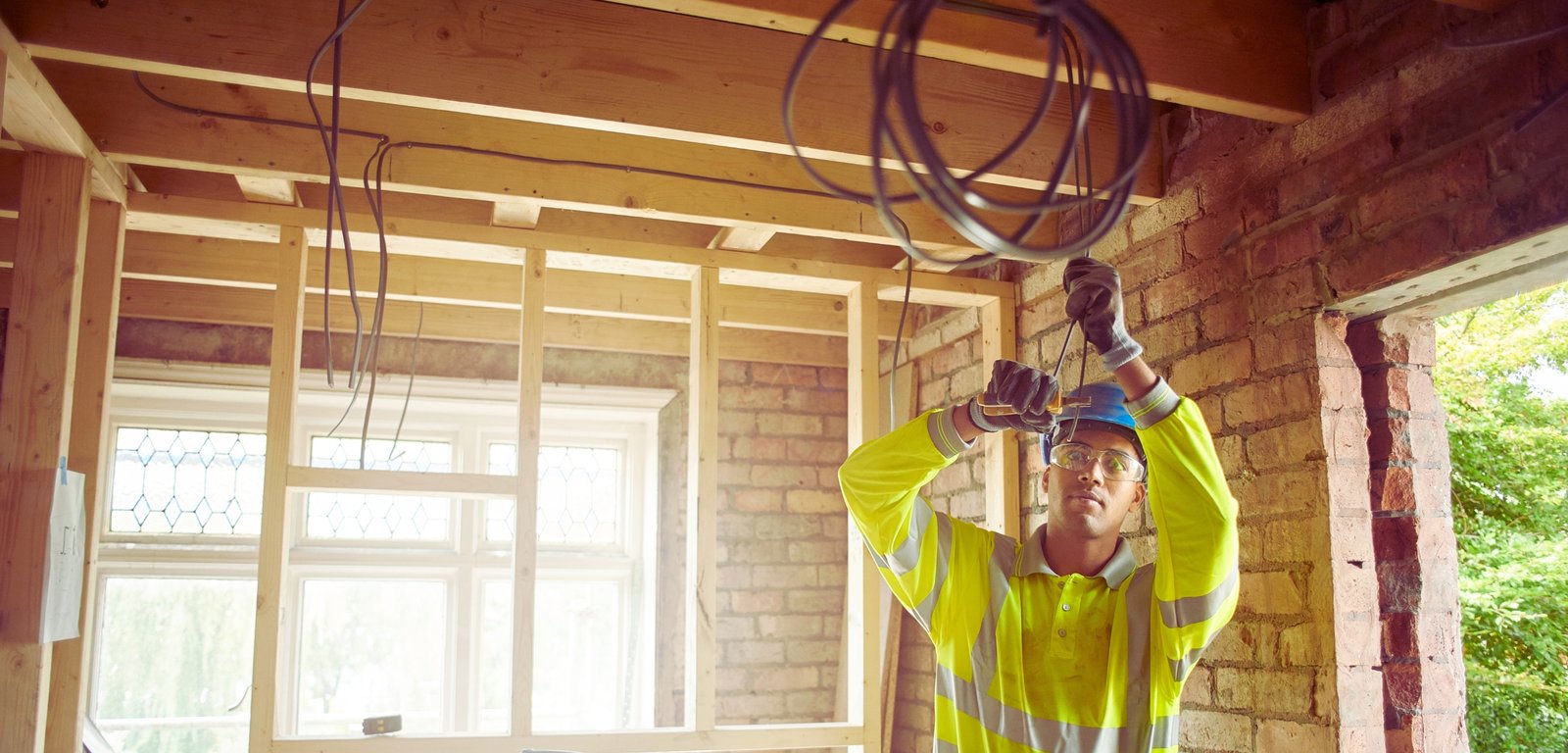No products in the cart.
If you’re wondering how to become an electrician, here’s the real answer: Get trained, get hands-on, and get certified. That’s the path. It’s not quick, and it’s not done from a desk. You learn by doing the job — on real sites, with real tools, next to real sparks.
This guide gives you everything you need. No fluff. Just what works in the field, in the UK, right now.
Step One: How to Get Started as an Electrician
Before you pick up your first tool, you need to know what you’re stepping into. Starting the trade takes more than interest — it takes the right groundwork.
The trade starts with basics. You need to meet the entry points before any toolbelt goes on. Most electricians begin with decent GCSEs — Maths and English especially. You don’t need perfect scores, but you do need to handle calculations, write job notes, and read diagrams.

Can’t tick the GCSE box? You can take Functional Skills Level 2 in Maths and English. Most training providers accept that.
You also need to be 16 or older. That’s the minimum age for apprenticeships. But there’s no upper limit. Many trainees start in their 30s, 40s, or beyond. This isn’t a kids-only gig. It’s open to anyone ready to work.
Recap: Get your basic qualifications sorted — Maths, English, and a serious mindset.
Step Two: Pick Your Training Route
Training can take more than one shape. Most new electricians choose between two clear paths: apprenticeship or college.
Apprenticeships combine work and study. You get paid, get trained, and gain experience all at once. You’re hired by a company, sent to college part-time, and trained on the job.
If you can’t land one right away, college is another option. You start with a Level 2 diploma and move to Level 3. These cover the science, safety, and technical skills you’ll need.
College gives you the theory. But after your courses, you’ll still need job-site experience to complete your qualifications. That’s where most students hit the wall — theory is easy to find, work experience isn’t.
Pro tip: Apprenticeships are competitive. Apply early and be ready to prove you’re serious.
What You Learn as a Trainee Electrician
You’ll be learning from day one — both in the classroom and on the job. Expect a mix of bookwork, workshop practice, and real-world wiring.
Some of the key skills you’ll pick up:
- Electrical science and circuit theory
- Safe isolation and inspection procedures
- Cable sizing, routing, and containment
- Wiring methods for lighting, sockets, and appliances
- Health and safety law on site
- Installation in domestic, commercial, and industrial settings
As an apprentice, you’ll work on everything from kitchen rewires to office refurbishments. If you’re in college, your practice will happen in training workshops — until you get hired.
Bottom line: You learn by doing. What you wire, test, or troubleshoot sticks far better than what you read.
Step Three: Get Site Experience
Classroom knowledge only goes so far. To become a qualified electrician, you need to get your hands dirty.
Many students become electricians’ mates after their courses. You assist a qualified spark. You carry tools, pull cables, and learn by doing. These roles let you build your portfolio for the NVQ Level 3.
Every install you help with, every diagram you read, and every test you perform goes into your evidence log. Assessors check your work. You photograph jobs, collect witness statements, and prove you meet national standards.
You can’t fake site time. And without it, no qualification sticks.
Key takeaway: The site is where you truly become an electrician — not just a student of the trade.
Step Four: Complete the NVQ and Pass Your AM2
You’ve got experience. Now you need to prove you can work to the industry standard — under real test conditions.
The NVQ Level 3 in Electrotechnical Systems is the one you want. It proves you’re competent, safe, and capable.
The final test is called the AM2. It’s a hands-on assessment. You’ll wire circuits, inspect them, fix faults, and answer theory questions. The test lasts a few days. It’s tough. You can’t wing it.
But once you pass, you’re officially qualified. You’ve earned the right to work unsupervised. More importantly, you’ve shown you can do the job right — under pressure.
Recap: The NVQ and AM2 are your final hurdles — treat them like a job site, not a school test.
Alternate Route: Experienced Worker Assessment (EWA)
Been working for years but lack paperwork? The EWA respects your time on the tools.
The Experienced Worker Assessment (EWA) is for electricians with 3 to 5+ years on the job. It lets you prove your skills through a portfolio, assessments, and the AM2E test.
You’ll need to pass a knowledge check, submit job evidence, and show you’re up to date with wiring regulations. Once you’re through, you qualify for the ECS Gold Card — same as someone who went the long route.
This isn’t a shortcut. It just respects the experience you’ve earned already.
Domestic Installer Route: Fast but Narrow
This is for those who only want to work on homes. If that’s you, this route might make sense.
Domestic installer courses cover basic installs, testing, and Part P of the Building Regulations. These usually run a few weeks. They qualify you for domestic-only jobs. Think fuseboards, sockets, lighting, and cookers.
Once trained, you register with a Competent Person Scheme like NAPIT or NICEIC.
This route doesn’t make you a full installation electrician. You can’t take on commercial or industrial work. But for starting a small domestic business, it works.
Heads up: If you plan to expand beyond houses, take the full training route instead.
Your Proof of Competence: Cards and Certs
At the end of the journey, you’ll need official proof that you’re qualified. That proof comes as an ECS Gold Card.
To apply, you need:
- NVQ Level 3 in Electrotechnical Systems
- City & Guilds 2382 (BS 7671 Wiring Regulations)
- ECS Health, Safety and Environment Test pass
You apply through the JIB’s online portal. Once approved, the card arrives in a few weeks.
Why it matters: This card shows employers and clients you’re legit — not just someone with tools.
Registering with Competent Person Schemes
If you want to self-certify your work (and skip building control inspections), you need to join a Competent Person Scheme.
The big names are NICEIC and NAPIT. To join, you’ll need to show:
- Proof of qualifications
- Evidence of recent electrical work
- Public liability insurance
- A commitment to BS 7671 standards
From March 2025, NICEIC will also ask for proof of Continuous Professional Development (CPD). That means you’ll need to keep your training up to date.
These schemes let you sign off your work legally and give customers peace of mind.
Where the Trade Can Take You
Getting qualified is just the start. The industry is full of ways to grow your career.
You can become a site supervisor, manage jobs, or move into estimating. Some electricians take the design route. Others train new sparks or become tutors.
Many go self-employed. You can run your own business, work flexibly, and pick your projects. Others go deeper — into renewables, data cabling, or smart homes.
Bottom line: Once qualified, your career can go in almost any direction you want.
Specialty Areas to Level Up Your Skills
Want to stand out? Specialise. These fields are growing fast and pay well for skilled sparks.
- EV charger installation
- Solar panel systems
- Fire alarm and security setups
- Building automation
- Industrial machinery
- Data and comms wiring
Each path comes with its own courses, certificates, and tools. But once qualified, your base skills make adapting easy.
Why CPD Isn’t Optional
The wiring regs change. So do the tools. If you don’t stay current, you fall behind.
You can’t stay sharp by standing still. CPD shows clients, employers, and schemes that you’re serious.
You can do CPD through:
- Short training courses
- Manufacturer workshops
- Online seminars and trade events
- Reading and self-study
Tip: Keep a log of your learning — NICEIC and NAPIT might ask to see it.
Skills That Set You Apart
Being good with tools isn’t enough. The best electricians bring more to the job. They solve problems. They stay organised. They stay calm when something trips out right before handover.
Top skills include:
- Strong communication
- Sharp attention to detail
- Practical problem-solving
- Physical coordination
- Good maths
- Solid timekeeping
- Pride in the job
Also, make sure your colour vision is normal. This trade relies on colour-coded wiring. If you’re not sure, get tested early.
The Final Word
So that’s the path. If you want to know how to become an electrician, it’s all here: Start with training, build real experience, pass your AM2, and keep learning. Whether you take the college route, the apprenticeship route, or come in as an experienced worker, the steps stay the same.
This is a trade that rewards hard work. It gives you freedom, steady pay, and real skills you can take anywhere. Flip the switch — your electrical career starts now.
If you’re ready to take this path seriously, start with the right foundation. Enrol in our online Professional Electrician course and begin with confidence.







